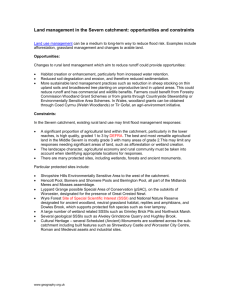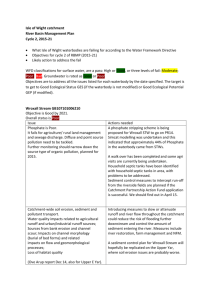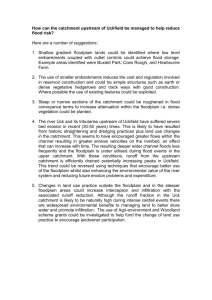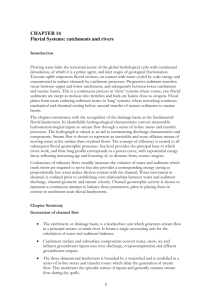Possible Catchment Outcomes
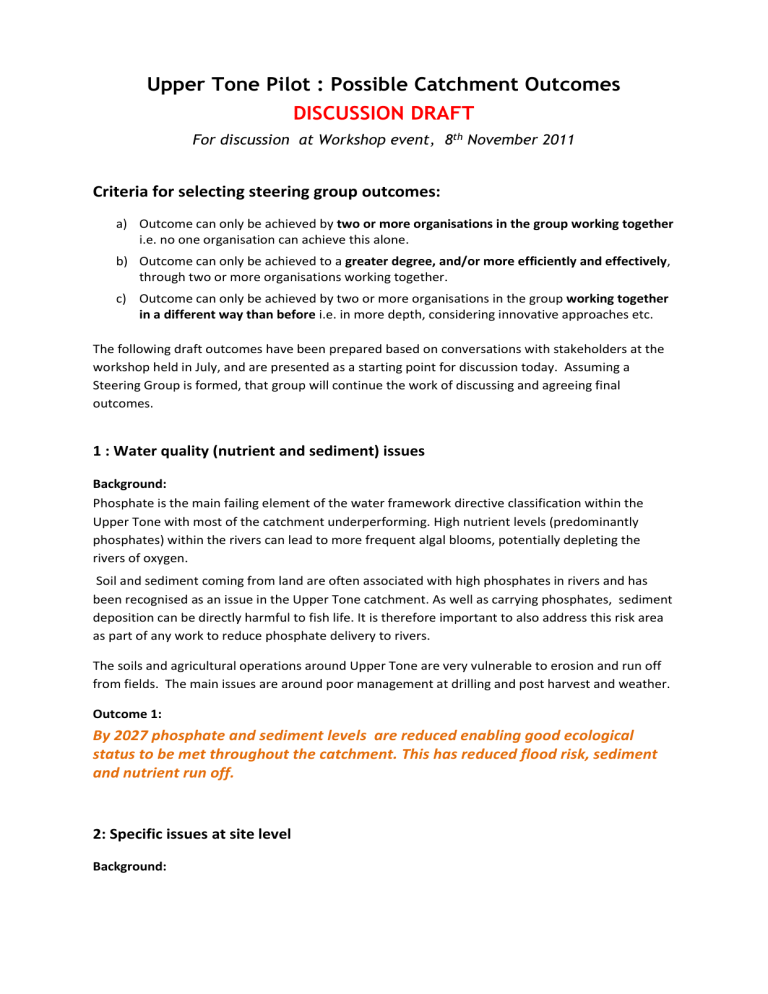
Upper Tone Pilot : Possible Catchment Outcomes
DISCUSSION DRAFT
For discussion at Workshop event, 8 th November 2011
Criteria for selecting steering group outcomes:
a) Outcome can only be achieved by two or more organisations in the group working together i.e. no one organisation can achieve this alone. b) Outcome can only be achieved to a greater degree, and/or more efficiently and effectively, through two or more organisations working together. c) Outcome can only be achieved by two or more organisations in the group working together
in a different way than before i.e. in more depth, considering innovative approaches etc.
The following draft outcomes have been prepared based on conversations with stakeholders at the workshop held in July, and are presented as a starting point for discussion today. Assuming a
Steering Group is formed, that group will continue the work of discussing and agreeing final outcomes.
1 : Water quality (nutrient and sediment) issues
Background:
Phosphate is the main failing element of the water framework directive classification within the
Upper Tone with most of the catchment underperforming. High nutrient levels (predominantly phosphates) within the rivers can lead to more frequent algal blooms, potentially depleting the rivers of oxygen.
Soil and sediment coming from land are often associated with high phosphates in rivers and has been recognised as an issue in the Upper Tone catchment. As well as carrying phosphates, sediment deposition can be directly harmful to fish life. It is therefore important to also address this risk area as part of any work to reduce phosphate delivery to rivers.
The soils and agricultural operations around Upper Tone are very vulnerable to erosion and run off from fields. The main issues are around poor management at drilling and post harvest and weather.
Outcome 1:
By 2027 phosphate and sediment levels are reduced enabling good ecological status to be met throughout the catchment. This has reduced flood risk, sediment and nutrient run off.
2: Specific issues at site level
Background:
Some sections in the Upper Tone catchment are under performing. These localised failures do not cause an overall classification failure but certain sections of the catchment are not as good as they should be.
The Upper Tone recorded site level failures for fish, invertebrates and macrophytes. The causes of these site level failures need to be addressed as there are clearly significant impacts on the local ecology.
Outcome 2:
By 2027 there will be no sections or stretches within the Upper Tone catchment failing to reach good ecological status due to issues with fish, invertebrates or macrophytes.
3 : Flood alleviation and water storage issues
Background:
With climate change likely to bring drier summers and wetter winters, there is an increasing need to ensure fluvial and surface water flood alleviation and water storage schemes in the catchment are sufficient for future needs. This should be done with a view to linking the two wherever possible, and managing water needs and resources in a sustainable way.
Outcome 3:
By 2027, significant local improvements have been secured that reduce fluvial and surface water flood risk and increase the amount of water that is available for all users in drier periods.
4 : Woodland creation and management
Background:
There is strong evidence that planting woodland in appropriate locations, (eg along field edges) and wider targeted woodland planting in the landscape can:
contribute to tackling diffuse pollution by trapping and retaining nutrients and sediment in runoff.
mitigate downstream flooding
reduce fertiliser and pesticide loss into water
reduce soil erosion
offset carbon emissions
Outcome 4:
4a) By 2027, more trees have been planted at strategic sites and new and existing woodland is managed in such a manner that flood risks are reduced and water quality is improved.
4b) By 2015 carbon saving from tree planting will be fed into a carbon credit scheme.
5) Management of bankside vegetation and riverside habitat
Background:
Uncontrolled stock access (cattle poaching) and poor bankside management are harming the ecology and water quality in parts of the Upper Tone. Fencing and keeping cattle out of watercourses can restore riverside habitat and improve water quality.
Outcome 5:
By 2027 there have been significant improvements in bankside management and riverside habitat.
6 : Renaturalising the river channel to support more habitats for wildlife
Background
River modification is extensive throughout the Upper Tone catchment for historic drainage or flood risk reasons. In order for the rivers to function more naturally, re-naturalising some sites would provide benefits for flood risk and biodiversity.
Outcome 6:
6a) by 2015 a list of sites that can be restored will be agreed as well as identifying what work is required and who will be responsible for restoring them .
6b) By 2027 wherever possible, modified river channels will be restored to a more naturalised state, without compromising social or economic functions.


